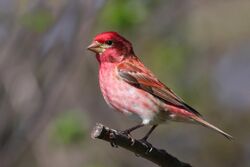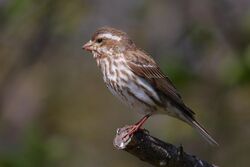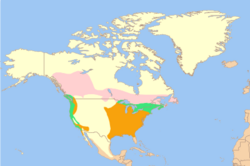Biology:Purple finch
| Purple finch | |
|---|---|

| |
| Male | |

| |
| Female | |
| Scientific classification | |
| Domain: | Eukaryota |
| Kingdom: | Animalia |
| Phylum: | Chordata |
| Class: | Aves |
| Order: | Passeriformes |
| Family: | Fringillidae |
| Subfamily: | Carduelinae |
| Genus: | Haemorhous |
| Species: | H. purpureus
|
| Binomial name | |
| Haemorhous purpureus (Gmelin, 1789)
| |

| |
| Range of C. purpureus Breeding range Year-round range Wintering range
| |
| Synonyms | |
|
Burrica purpurea | |
The purple finch (Haemorhous purpureus) is a bird in the finch family, Fringillidae. It breeds in the northern United States, southern Canada, and the west coast of North America.
Taxonomy
The purple finch was formally described in 1789 by the German naturalist Johann Friedrich Gmelin in his revised and expanded edition of Carl Linnaeus's Systema Naturae. He placed it with the finches in the genus Fringilla and coined the binomial name Fringilla purpurea. Gmelin specified the locality as Carolina.[2][3] Gmelin based his account on the "purple finch" that had been described and illustrated by the English naturalist Mark Catesby in his book The Natural History of Carolina, Florida and the Bahama Islands.[4] The purple finch is now one of three finches placed in the genus Haemorhous that was introduced in 1837 by the English naturalist William Swainson.[5]
Two subspecies are recognised:[5]
- H. p. purpureus (Gmelin, JF, 1789) – central south, southeast Canada and northeast USA
- H. p. californicus (Baird, SF, 1858) – southwest Canada and west USA
This species and the other "American rosefinches" were formerly included with the rosefinches of Eurasia in the genus Carpodacus; however, the three North American species are not closely related to the rosefinches of the Old World, and have thus been moved to the genus Haemorhous.[5][6]
Description
The purple finch is 12–16 cm (4.7–6.3 in) in overall length and weighs 18–32 g (0.63–1.13 oz). It has a short forked brown tail and brown wings. Adult males are raspberry red on the head, breast, back and rump; their back is streaked. Adult females have light brown upperparts and white underparts with dark brown streaks throughout; they have a white line on the face above the eye.
The subspecies H. p. californicus differs from the nominate in having a longer tail and shorter wings. The plumage of both males and females is darker, and the coloration of the females is more greenish.[7] It also has a longer bill.[8]
Distribution and habitat
Their breeding habitat is coniferous and mixed forest in Canada and the northeastern United States, as well as various wooded areas along the U.S. Pacific coast.
Birds from northern Canada migrate to the southern United States; other birds are permanent residents.[citation needed]
The purple finch population has declined sharply in the East due to the house finch. Most of the time, when these two species collide, the house finch outcompetes the purple finch. This bird has also been displaced from some habitat by the introduced house sparrow.[9]
Behavior
Food and feeding
These birds forage in trees and bushes, sometimes in ground vegetation. They mainly eat seeds, berries, and insects. They are fond of sunflower seeds, millet, and thistle.
Breeding
The purple finch prefers nesting in lowland coniferous and mixed forests, avoiding more heavily populated urban areas, but sometimes found in rural residential areas. The female Purple Finch usually builds her nest on horizontal branches of coniferous trees, away from the trunk, but occasionally in tree forks. The nest is shaped like an open cup, made up of rootlets, twigs, and weeds, and lined with grass, hair, and moss.
Cultural depictions
This is the state bird of New Hampshire. In 1763, Richard Brookes made the description of the female purple finch in Mexico with the name of "chiantototl" (chia seed bird).[10]
References
- ↑ BirdLife International (2016). "Haemorhous purpureus". IUCN Red List of Threatened Species 2016: e.T22720553A94672558. doi:10.2305/IUCN.UK.2016-3.RLTS.T22720553A94672558.en. https://www.iucnredlist.org/species/22720553/94672558. Retrieved 11 November 2021.
- ↑ Gmelin, Johann Friedrich (1789) (in Latin). Systema naturae per regna tria naturae : secundum classes, ordines, genera, species, cum characteribus, differentiis, synonymis, locis. 1, Part 2 (13th ed.). Lipsiae [Leipzig]: Georg. Emanuel. Beer. p. 923. https://www.biodiversitylibrary.org/page/2656418.
- ↑ Paynter, Raymond A. Jr, ed (1968). Check-List of Birds of the World. 14. Cambridge, Massachusetts: Museum of Comparative Zoology. p. 270. https://www.biodiversitylibrary.org/page/14481471.
- ↑ Catesby, Mark (1729–1732) (in English, French). The Natural History of Carolina, Florida and the Bahama Islands. 1. London: W. Innys and R. Manby. p. 41, Plate 41. https://www.biodiversitylibrary.org/page/40753241.
- ↑ 5.0 5.1 5.2 Gill, Frank; Donsker, David; Rasmussen, Pamela, eds (July 2023). "Finches, euphonias". IOC World Bird List Version 13.2. International Ornithologists' Union. http://www.worldbirdnames.org/bow/finches/.
- ↑ Zuccon, Dario; Prŷs-Jones, Robert; Rasmussen, Pamela C.; Ericson, Per G.P. (February 2012). "The phylogenetic relationships and generic limits of finches (Fringillidae)". Molecular Phylogenetics and Evolution 62 (2): 581–596. doi:10.1016/j.ympev.2011.10.002.
- ↑ Bailey, Florence Merriam; Fuertes, Louis Agassiz (1921). Handbook of Birds of the Western United States. Houghton Mifflin. pp. 310. https://archive.org/details/handbookbirdswe02bailgoog.
- ↑ Kaufman, Kenneth (1999). A Field Guide to Advanced Birding. HMCo Field Guides. pp. 267–268. ISBN 0-395-97500-X. https://books.google.com/books?id=Jlb7Gyhi3IIC&q=Carpodacus+purpureus+%2B+red&pg=PA267.
- ↑ Wootton, J. T. (1987). "Interspecific Competition between Introduced House Finch Populations and Two Associated Passerine Species". Oecologia 71 (3): 325–331. doi:10.1007/BF00378703. PMID 28312977.
- ↑ Brookes, Richard (1763). The Natural History of Birds. Vol 2, p 205.
External links
| Wikimedia Commons has media related to Haemorhous purpureus. |
- Interesting Purple Finch Facts at BirdHouses101.com
- "Purple Finch media". Internet Bird Collection. http://www.hbw.com/ibc/species/purple-finch-carpodacus-purpureus.
- Purple Finch photo gallery at VIREO (Drexel University)
- Purple Finch Species Account – Cornell Lab of Ornithology
Wikidata ☰ Q27075782 entry
 |



